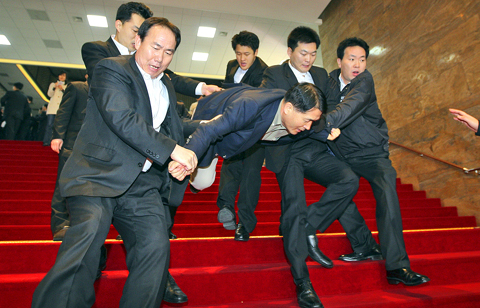Clashes broke out in South Korea yesterday when security guards tried to break up a protest by opposition lawmakers that has paralyzed parliament for weeks.
Several people were injured in the scuffle that broke out when about 200 guards began forcibly removing lawmakers holding a sit-in in the parliament building.
TV footage showed security guards grabbing some of the lawmakers by the arms and legs, while others linked arms and chanted slogans in protest.

PHOTO: AP
“I’ve never seen anything like this, even during the [late president Park Chung-hee’s] Yushin dictatorship,” said Chung Sei-kyun, leader of the main opposition Democratic Party (DP), who led the protest.
Authorities at the National Assembly had earlier asked the DP to end its sit-in and remove banners from the building’s walls.
Scores of DP legislators had occupied parliament since the middle of last month to prevent the ruling Grand National Party (GNP) pushing through a free trade pact with the United States and other controversial bills.
Clashes involving sledgehammers and fire extinguishers broke out on Dec. 18 after the GNP insisted the free trade pact, signed by Seoul and Washington last year but awaiting ratification by both legislatures, be approved quickly.
The opposition, which has 83 seats in the 299-member legislature compared with the GNP’s 172, said South Korea should not ratify it until the US Congress also moves to do so.
The ruling party has argued that the pact as necessary to stimulate the slowing economy and argues that approval by Seoul will encourage the US Congress to move faster.
But there is strong opposition to the pact among including farmers and other workers who fear it will hit jobs.
Also controversial is a bill to allow large businesses and newspapers to acquire controlling stakes in local broadcasters, which critics would strengthen the right’s control on news media.
The rival parties are also wrangling over tax cuts for the wealthy, easing regulations on industrial conglomerates’ ownership of banks and privatizing the state-run Korea Development Bank.

WEAKER ACTIVITY: The sharpest deterioration was seen in the electronics and optical components sector, with the production index falling 13.2 points to 44.5 Taiwan’s manufacturing sector last month contracted for a second consecutive month, with the purchasing managers’ index (PMI) slipping to 48, reflecting ongoing caution over trade uncertainties, the Chung-Hua Institution for Economic Research (CIER, 中華經濟研究院) said yesterday. The decline reflects growing caution among companies amid uncertainty surrounding US tariffs, semiconductor duties and automotive import levies, and it is also likely linked to fading front-loading activity, CIER president Lien Hsien-ming (連賢明) said. “Some clients have started shifting orders to Southeast Asian countries where tariff regimes are already clear,” Lien told a news conference. Firms across the supply chain are also lowering stock levels to mitigate

Six Taiwanese companies, including contract chipmaker Taiwan Semiconductor Manufacturing Co (TSMC, 台積電), made the 2025 Fortune Global 500 list of the world’s largest firms by revenue. In a report published by New York-based Fortune magazine on Tuesday, Hon Hai Precision Industry Co (鴻海精密), also known as Foxconn Technology Group (富士康科技集團), ranked highest among Taiwanese firms, placing 28th with revenue of US$213.69 billion. Up 60 spots from last year, TSMC rose to No. 126 with US$90.16 billion in revenue, followed by Quanta Computer Inc (廣達) at 348th, Pegatron Corp (和碩) at 461st, CPC Corp, Taiwan (台灣中油) at 494th and Wistron Corp (緯創) at

NEGOTIATIONS: Semiconductors play an outsized role in Taiwan’s industrial and economic development and are a major driver of the Taiwan-US trade imbalance With US President Donald Trump threatening to impose tariffs on semiconductors, Taiwan is expected to face a significant challenge, as information and communications technology (ICT) products account for more than 70 percent of its exports to the US, Chung-Hua Institution for Economic Research (CIER, 中華經濟研究院) president Lien Hsien-ming (連賢明) said on Friday. Compared with other countries, semiconductors play a disproportionately large role in Taiwan’s industrial and economic development, Lien said. As the sixth-largest contributor to the US trade deficit, Taiwan recorded a US$73.9 billion trade surplus with the US last year — up from US$47.8 billion in 2023 — driven by strong

ASE Technology Holding Co (ASE, 日月光投控), the world’s biggest chip assembly and testing service provider, yesterday said it would boost equipment capital expenditure by up to 16 percent for this year to cope with strong customer demand for artificial intelligence (AI) applications. Aside from AI, a growing demand for semiconductors used in the automotive and industrial sectors is to drive ASE’s capacity next year, the Kaohsiung-based company said. “We do see the disparity between AI and other general sectors, and that pretty much aligns the scenario in the first half of this year,” ASE chief operating officer Tien Wu (吳田玉) told an